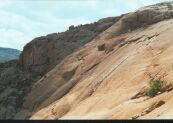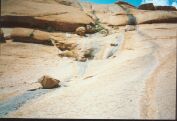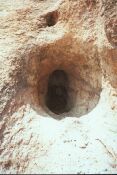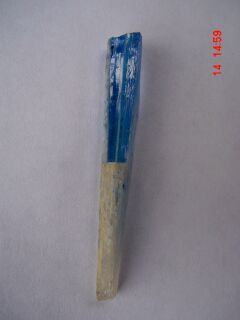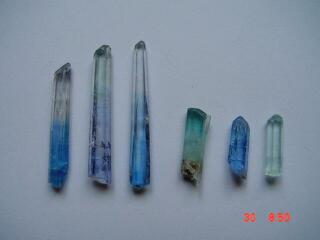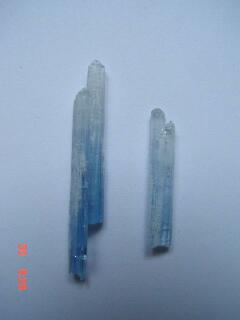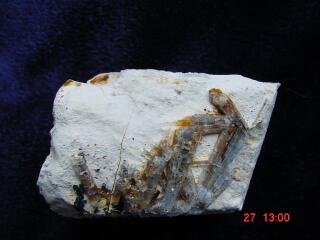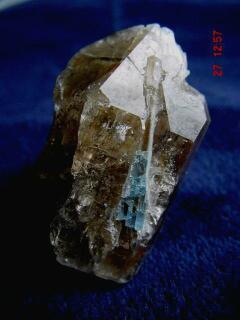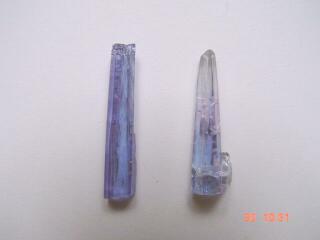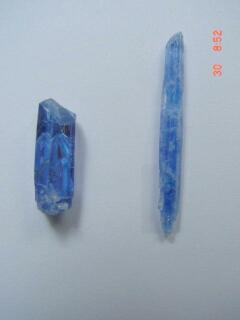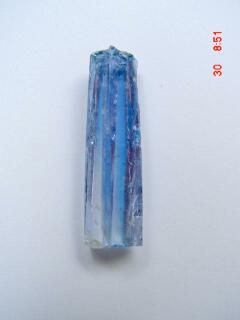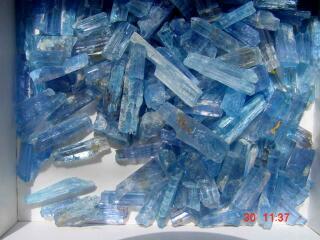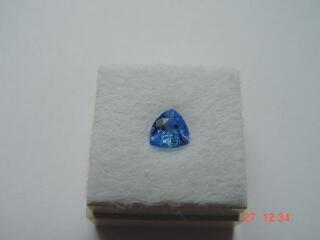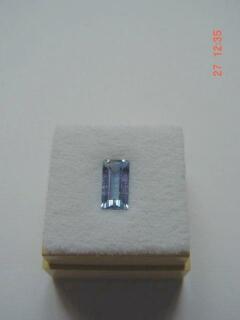Georg Gebhard, Großenseifen; Johannes Brunner, Windhoek Jeremejevite from Ameib, Erongo, Namibia - A new and probably the best find ever made.
Only a few localities of this rare borate mineral are known
worldwide. Jeremejevite was discovered in 1869 at Mt. Soktuj, a northerly extension of the Adun-Chilon Range in Dauria, Nertschinsk District, eastern Siberia. Only a few isolated crystals up to 5 cm in length and one
specimen have been reported from the type locality. The crystals resembled a yellowish beryll in appearance. For more than 100 years, this mineral was one of the rarest of all known minerals. But in 1973 a second
occurrence of Jeremejevite was found at a small pegmatite mine known as” Mile 72” north of Swakopmund, Namibia. The mine was exploited by the well-known mineral dealer Sid Pieters. Only a few crystals were found, which
showed a fine blue color. In 1976 a pocket was hit that produced about 100 of the finest known crystals of blue Jeremejevite measuring up to 5 cm in length and 0.5 cm in diameter. Very few crystals on matrix were found.
Actually, more mounted specimens are existing, where crystals of Jeremejevite are glued on feldspar. Since this find, Jeremejevite became a highly sought-after mineral by collectors worldwide. The big demand for
this gem mineral might have been the reason for new mining activities at the Namibian deposit some years ago. This operation did not succeed much although about 100 000 tons of material have been removed. A handful of
single colorless to yellowish crystals up to 3 cm length and one blue crystal were the result of that project. Meanwhile, Jeremejevite is reported from two further localities: microcrystals in volcanic ejecta from the
Eifel in Germany and Pamir Mountains in Tadzhikistan. The latter find is not well documented. About 10 yellow to brown crystals of little transparency up to 5 cm in length are reported from this locality. Since two
years, the Erongo Mountains near Usakos are a source for exceptional aquamarine, topaz, fluorite and the finest specimens known of the new member of the tourmaline group: foitite ( detailed informations will be given in
a separate report on this outstanding find, coming next on this website). Since the beginning of this year, very fine combinations of a reddish-black tourmaline – the species is not yet determined – and gemmy blue and
green beryls came out of a place not far away from the locality of the great aquamarine find of May 2000. The new locality is at the border between the farms Davib-Ost and Ameib and exhibits a stunning view to
the area of the farm Davib-Ost.
The steep surface of the granite shows pipes ending on the surface of the granite which are connected by a blue-gray line on the photo.
The crystals were thought to be small beryls of an unusual blue-lavender color, so that not much
intention was paid to discover more of these “beryls” instead of the bigger crystals in other cavities. But who thought about jemerejewite when we examined these crystals? Surprisingly, the
results left no question open: these “beryls” were Jeremejevite. We asked the miners to look more intensively for these crystals of an unusual color. The result ended up in a few hundreds of crystals
of different colors, but mostly colorless. Most of these crystals do not exceed 1 cm. About 30 larger crystals up to 5 cm length and 1 cm wide occurred also. One of the longest crystals: 48x5 mm, 12 carat
A not yet proven information on an 8 cm long crystal has been given so far. The crystals range in color from light blue to lavender and to greenish even, with nearly all shades.
It is remarkable that only the colorless and pale blue crystals have terminations. All deep blue
crystals end without terminations. The habit varies from stubby, beryl-like crystals to long, needle-like crystals. The non-terminated end is always wider and more blue than the terminated
end of the crystal. Only a few groups of crystals have been found. Largest crystal measures 38 mm
Rarely, groups of crystals have been found
Parallel growth of crystals, left: 44 mm, 8 carat; right: 32 mm, 3 carat
A few specimens occurred where Jeremejevite crystals are attached to a matrix, either of orthoclase or smoky quartz. It seems that originally the loose crystals were also attached to feldspar. Jeremejevite on feldspar, 6x4 cm
Jeremejevite on quartz, 3x5 cm
The feldspar is partially covered by small blue and green fibrous crystals of blue and green fibres of tourmaline. Besides these crystals, no other mineral has been found in the pocket.
What are the main differences in appearance between this find and the former finds of Jeremejevite? 1. Nearly all crystals are of gem quality.
2. The color varies from colorless to lavender and blue, some crystals are color-zoned along the c-axis. L avender colored crystals, left: 27 mm long, 4 carat; right: 26 mm long, 5 carat
Deep blue crystals, left: 6 carat; right: 37 mm
3. Blue crystals show a strong pleochroism from colorless to cornflower blue and lavender, which even can be seen without rotating the crystal, due to the twisted faces.
Crystal, 35x10 mm,18 carat
By cutting these Jeremejevite crystals according to their pleochroism superb gems can be produced .
Cutting material
0.4 carat
0.6 carat
Still some questions are open to discussions and investigations: What is the reason for the different colors – defects in the structure or trace elements?
Why are only colorless or pale blue crystals terminated?
Referring to the locality of the find, it should be mentioned, that the farmers are planning to establish a wildlife reserve center in this region to protect flora and fauna.
References
WEBSKY, M.(1884) Über Jeremejewit und Eichwaldit vom Berge Soktuj in Daurien. N. Jb. Miner. , 1-17
HERTING, S. and Strunz, H. (1978) Jeremejewit vom Cape Cross in SW-Afrika. Der Aufschluß, 29, 45-53
Ordering Jeremejevite
|

